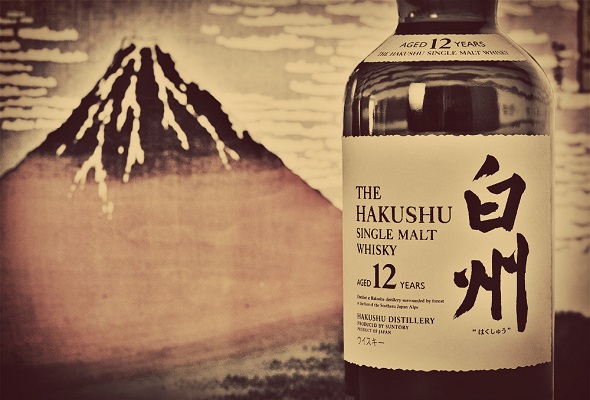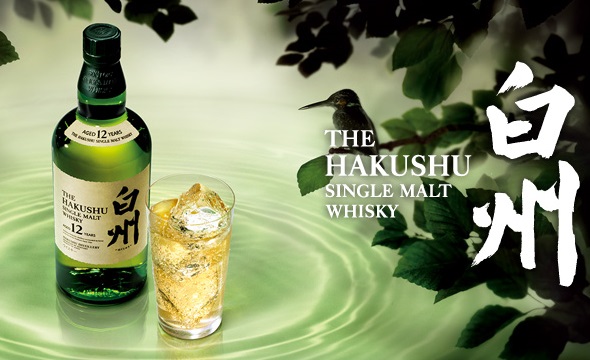This is part three of our ongoing series on Japanese whisky. To get started, see part one and part two.
At the beginning of this series, I mentioned receiving a bottle of Hakushu 12 from Cocktail Enthusiast two years ago. Below is the review I wrote. I think it deserves to be revisited, not only because I have revisited the spirit myself and added our first star rating, but also to reflect on the context of the time it was written. Here we are two years later, and what at the time seemed a novel new whisky (for stateside drinkers, at least) has since helped to bolster a serious movement. The playful and peated Hakushu 12 — and Japanese whisky in general — has enjoyed a leap in Western demand. And more importantly, supply of Hakushu 12 has increased significantly. This will be even more noticeable now that Suntory has parted ways with Campari USA in order to self distribute after its acquisition of Beam. Kanpai my friend, the good stuff is coming your way. Now, to the review.
Hakushu 12 Year Old Japanese Whisky
“Whisky, like a beautiful woman, demands appreciation. You gaze first, then it’s time to drink.”
The words of one of my heroes: literary great, Haruki Murakami, a Japanese man who loves his whisky. And he’s not alone. Ever since a young organic chemist named Masataka Taketsuru brought the secrets of Scotch whisky production home to Takehara in 1920, the Japanese have been busy perfecting this favorite tipple to great success. A few renowned Japanese whisky brands have arisen, but none so universally recognized as that of the Suntory group.
When I received a bottle of their 12 year Hakushu single malt, I was only familiar with the Yamazaki line. It was a pleasure to reach for the Yamazaki 12 on the back bar, as it serves to satisfy the novice Scotch drinker, amuse the whisky veteran and even fortify a few damn good cocktails. But I was always careful to make a distinction between the Japanese and the Real McCoy. Despite traces of peat and the sooty caramel of oak casks, Yamazaki is bright, fruity, almost tropical; that could sometimes make it a hard sell with die hard peat lovers. I entered into Hakushu’s 12 year single malt with a similar frame of mind.
So I was pleasantly surprised by what I found. Deceptively bright and citrusy on the nose, Hakushu strikes on the first sip like Musashi. Pear and lemon quickly give way to spice and smoke, nuts and malted barley, and a woody finish with our favorite Scotch topsoil. It’s like a well-balanced meal with every sip. And it leaves you with satisfying, lingering flavors of malt and peat. The line hadn’t been peated until this generation, so I’m happy to taste the new results.
In order to achieve this lightly peated flavor, Hakushu blends a batch of unpeated whisky with heavily peated whisky, both distilled at the same distillery from the same kind of malt (thereby maintaining its single malt status). Between that, an aging in American oak, Japanese oak and Spanish sherry casks, and the distillery’s location in the Japanese Alps, I’d say Suntory has moved from producing something akin to a mild Highland to a stout Speyside. Good on ya, boys.
Stats:
– 43% ABV
– $55 – $70
CE Rating: ★★★★*
A side-by-side comparison of Suntory’s two distilleries is a fun experience (and improves with repetition), but when you get your hands on a bottle of Hakushu, hang on to it. It’s only been available in the States since December 2011, and can still prove tough to find. That said, I have little doubt that this great showing will be just as recognized in a few years’ time; Japanese whisky is on the rise in the Western world. That’s something I’ll wager Murakami could toast to. Likely with a glass of Hakushu 12 year.
And stay tuned, as next week we’ll be reviewing Yamazaki 18 Year.
*A note: I’ve decided to begin employing a rating system in order to help quantify my reviews of spirits. At the risk of feeling fraudulent in fretting over a rating of 89 or 90, I have opted instead to apply F. Paul Pacult’s five star rating system used in his Spirit Journal.




